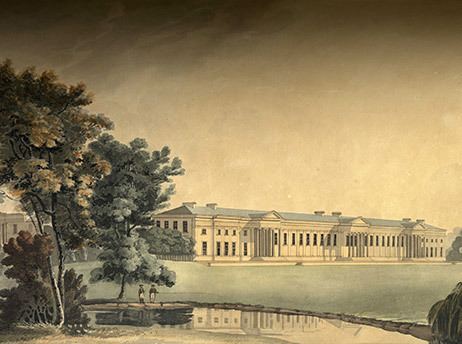Founder East India Company | ||
 | ||
The East India Company College, or East India College, was an educational establishment situated at Hailey, Hertfordshire, nineteen miles north of London founded in 1806 to train "writers" (administrators) for the Honourable East India Company (HEIC). It provided general and vocational education for young gentlemen of sixteen to eighteen years old, who were nominated by the Company's directors to writerships in its overseas civil service.
Contents
- History
- Closure and later use of buildings
- Principals
- Deans
- Registrars
- Languages
- Law
- Political Economy
- Mathematics and Natural Philosophy
- Classical and General Literature
- Other
- Notable alumni
- References
The college's counterpart for the training of officers for the company's Presidency armies was Addiscombe Military Seminary, Surrey.
The buildings are now occupied by Haileybury and Imperial Service College.
History
Charles Grant, Chairman of the British East India Company and Member of Parliament, was closely involved in the foundation of the college. It was first located in Hertford Castle but it was evident that a purpose-built seat of learning would be more suitable and in October 1805 the company purchased an estate just outside Hertford Heath for the sum of £5,930 for this objective. The foundation stone of the new buildings were laid on 12 May 1806. The buildings cost the East India Company £92,000 at the time of their erection to the designs of the architect William Wilkins (who later designed the National Gallery in London). The grounds were landscaped by Humphry Repton, his most notable work here being the terraced area to the front of Wilkins' main range and ponds to the west of this. Repton submitted his final account for work undertaken here just eight days before a carriage accident which left him crippled. The new buildings were occupied by students in 1809.
The East India Company had been incorporated in 1600 as a commercial entity. For two hundred years its administrators had been recruited, largely by patronage, to oversee commercial transactions in Asia. By 1800 they had become the de facto government for millions of people in those areas, but without much training for the role. The college was intended to address these shortcomings. In fifty years it trained over two thousand so-called "writers" to administer the Indian subcontinent.
The curriculum was wide, detailed, and targeted to the career responsibilities. It included political economy, history, mathematics, natural philosophy, classics, law and humanity and philology. Languages included Arabic, Urdu (Hindustani), Bengali, Marathi, Sanskrit, Telugu and Persian. Among the tutors were some of the finest minds of the day, many from Oxford and Cambridge, with lavish annual salaries as much as £500.
The college was customarily referred to as "Haileybury" in contemporary accounts, debates in the House of Lords and the House of Commons and by the administrators of the East India Company and the Colonial Civil Service. From 1839 the College had a journal known as The Haileybury Observer.
The East India Company itself was seen as too powerful. There was pressure for meritocracy to replace recruitment by patronage. Graduates of universities in Great Britain should have the chance to serve in India, without needing to pass through the college. In 1855, Parliament passed an act "to relieve the East India Company from the obligation to maintain the College at Haileybury". King's College, London, hosted the first open competitive examinations for appointment to the Indian Civil Service.
Closure and later use of buildings
In the aftermath of the Indian Rebellion of 1857, and in anticipation of the winding-up of the affairs of the East India Company itself, the college was closed in January 1858. For a brief period the buildings became a military depot for troops destined for India. During this interregnum the college's Master, Revd Henry Melvill, and Registrar, Revd James William Lucas Heaviside, continued to live in their residences on the site and oversaw the maintenance of the buildings. The leading Hertford publisher Stephen Austin, who had been the official printer to the East India Company’s College and thus become one of the leading printers of books in various Oriental languages, led a campaign to ensure the buildings were returned to some sort of academic purpose and the college ultimately reopened as the public school Haileybury in 1862 (formally constituted by Royal Charter on August 30, 1864). During the Victorian era the difference between the two periods of education on the site were referred to as "Old Haileybury" and "New Haileybury". In its early years the new school retained close links to those involved in colonial administration and it would ultimately merge with the Imperial Service College in 1942 to become Haileybury and Imperial Service College.
Principals
The college had four principals:
Deans
The position of dean was filled by one of the professors:
Registrars
The position of registrar was filled by one of the professors:
Languages
Law
Political Economy
Mathematics and Natural Philosophy
Classical and General Literature
Other
Assistants in the Oriental Department included Maulavi Abdal Aly (1809–12), Maulavi Mirza Khedel (1809–19), The Revd. Robert Anderson (1820–25), and David Shea (1826–36). Moonshy Ghoolam Hyder and Thomas Medland taught oriental writing.
